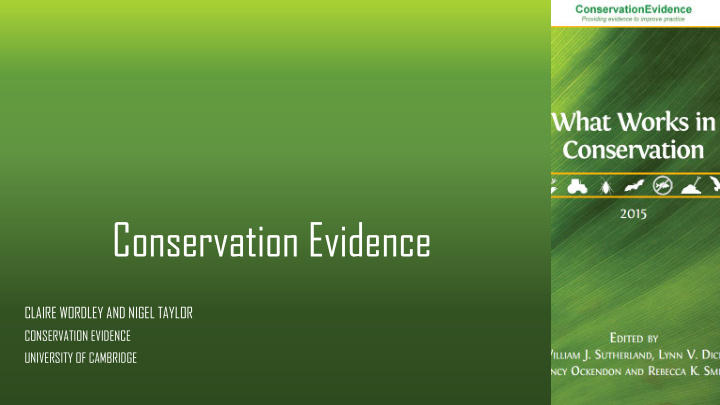



Conservation Evidence CLAIRE WORDLEY AND NIGEL TAYLOR CONSERVATION EVIDENCE UNIVERSITY OF CAMBRIDGE
Science: Using and Doing • Think of a recent project you've undertaken. • What information did you look for at the start of the project? • Where did you find it? • How did it change your thinking or planning?
Science: Using and Doing • Think of a recent project you've undertaken. • What monitoring did you undertake? • How did you decide what to monitor? • How did you communicate the key outcomes? • Who did you reach?
Conservation Evidence Set up by Professor Bill Sutherland in 2004 Based at the University of Cambridge www.conservationevidence.com
Using Conservation Evidence Search CE website for appropriate studies
Using Conservation Evidence Click through to look at evidence
Using Conservation Evidence Scroll down
Using Conservation Evidence Click through to look at evidence
The Conservation Evidence project Summarising evidence and encouraging its use by practitioners
The Conservation Evidence project Encouraging Summarising evidence generation of new and encouraging its evidence by use by practitioners practitioners Enabling the publishing of new evidence to share with others
The Conservation Evidence journal
The Conservation Evidence journal
Publishing a paper
Conservation Evidence Journal Free Open access At least one non-academic per paper Testing interventions Does not have to be long No need for huge novelty/broad applicability We try to be helpful not brutal
Conservation Evidence Journal
Generating evidence for wetland conservation: Designing and carrying out experiments
Why should we do experimental conservation? Learn from successes – and failures (30% interventions in CE journal did not work!) Able to see how different approaches compare to each other Get away from subjective opinions Make conservation more effective
What is the question? Develop a clear question, rather than just monitoring ‘to see what happens’. Questions must be SMART: Specific Measurable Achievable Relevant Time-bound
SMART questions For example… “ We aim to monitor the impact of rewetting on peatland plants ” vs “ Do Sphagnum abundance and peatland plant species diversity change in the first five years after rewetting and if so, by how much ? Are the changes statistically significant ?”
What are you measuring, and to answer which question? Will the data you are collecting answer your question ? e.g. Are you looking at species presence/ abundance/ community composition ? Are you interested in vegetation biomass, height or density? Are you interested in one particular species , or the whole community ?
Consistency ‘Compare like with like’. Using the same survey method and equipment in the same location at comparable times (of year, per night etc) in comparable weather
How will you analyse the data? BEFORE you gather the data, plan how you will analyse it. Will your data meet the basic requirements for a t-test? An ANOVA? Are you looking at a year by year trend? Will you measure potential confounding factors such as weather that year in your analysis?
In summary Ask a clear, answerable question. Decide on analysis method before you gather data. Decide what you are measuring, and do it consistently. Choose appropriate methods and equipment. Implement methodology consistently. Ensure adequate length of study and number of repeats. Try to measure/control for confounding factors.
Basics of study design
Basics of study design You want to design a study to test whether excluding sheep will affect vegetation in a bog. The bog has two distinct areas: one that is much wetter and one that is much drier. How would you test this? 15 mins to plan studies in 2 groups using materials provided
Study design Adding different elements to your study can make it stronger Controlled Before and after Replicated Paired Randomised Repeated
Keep in touch Info: cfw41@cam.ac.uk Journal: no200@cam.ac.uk Twitter: @ConservEvidence Facebook: ConservationEvidence.com www.conservationevidence.com
Recommend
More recommend